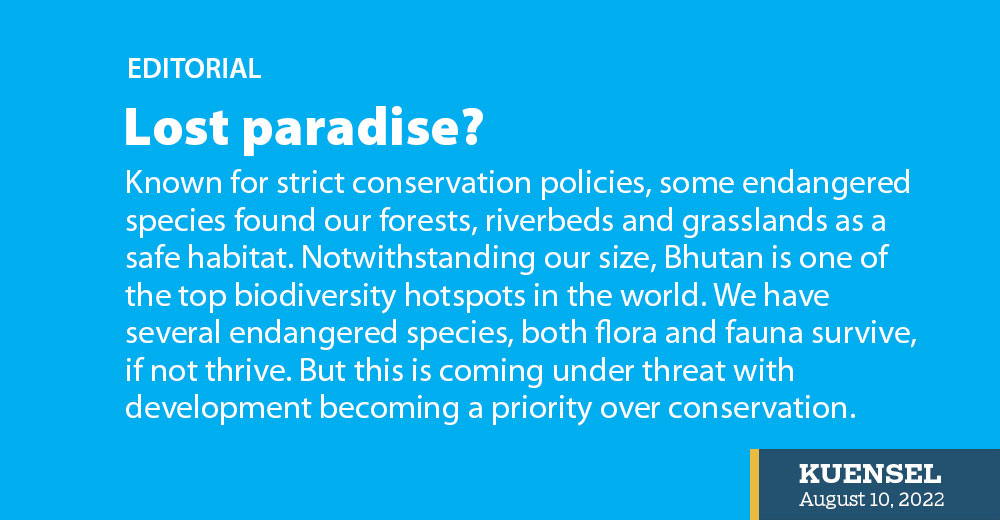Known for strict conservation policies, some endangered species found our forests, riverbeds and grasslands as a safe habitat. Notwithstanding our size, Bhutan is one of the top biodiversity hotspots in the world. We have several endangered species, both flora and fauna survive, if not thrive. But this is coming under threat with development becoming a priority over conservation.
In hindsight, it was the policy of the past that was conservation-friendly. The greed for economic prosperity has pushed some of the wise policies into the background. Rare birds are being scared away from their habitat because of road-widening projects, tigers are being hunted, even if illegal, for skin and bones. The black-necked crane population is dwindling as they find their roosting grounds converted into concrete jungles.
The white-bellied heron (WBH) is a rare bird in the world. There are only about 60 in the entire world. Bhutan has about 13.8 percent or 23 of the total birds. The bird is so elusive and sensitive that the slightest disturbance to its habitat could result in extinction.
Listed as critically endangered on the IUCN Red List since 2007, WBH is losing its habitat. A recent RSPN analysis of population trends within the zones where the birds flock indicates that the population is disappearing from Phochhu and Mochhu to Kamichhu near Punakha and Wangduephodrang. Called Zone I, this was once a thriving habitat.
The hydropower projects and developments along the banks of Punatsangchhu river have scared the birds away. The last herons sighted in the zone was in 2018. No herons were sighted in Zone I for the past two consecutive years. Going by the study, it is evident that disturbance caused by construction activities is affecting their breeding grounds. The Kuri-Gongri basin until Bumdeling, Trashiyangtse was once a rich habitat. No birds were sighted in the last two years. It coincided with the construction of the Kholongchhu hydropower project.
It is proven that human activities like natural resource extraction, infrastructure development, timber and firewood collection and hydropower development are a threat to their survival. As a developing country that is dependent on the construction and hydropower industry for improved GDP growth, not many would think of preserving bird habitats. Only a few would value the worth of rare species.
With elected governments having to deliver promises and prove economic growth, conservation of the environment and rare species are not on the priority list. We are rich in biodiversity because of the wisdom of our past leaders who always ensured balanced development.
The birds’ cry is not loud enough for the government to hear. It is subdued by the loud noises of turbines or vehicles running through their habitat. However, for the sake of conservation, it would be worthwhile to relook into preserving rare habitats of rare species including the white-bellied heron.
Economically, bird watching, especially rare birds, could provide the high value we are chasing after increasing the sustainable development fee to USD 200 a person per day. Even if not economically viable, we could help save some of the rarest species for our future generations. At the rate of extinction of rare species, our children will read about the WBH only in school textbooks.


